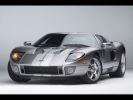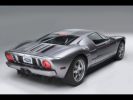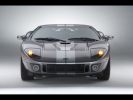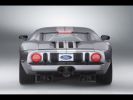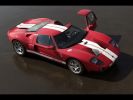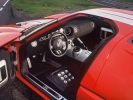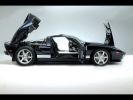The Supercar Resource
2005 Ford GT
Pictures and Specifications
|
Click on above picture to view wallpaper-size picture. |
||
Ford GT
It was in France, in the mid-1960s, that the great American supercar came to life. A low-slung, muscular racing car built to win on the legendary Le Mans race circuit, the GT project was spearheaded by no less a powerhouse than company Chairman and CEO Henry Ford II. His goal was to change performance car history. And he did. The GT beat the world's best in endurance racing, placing 1-2-3 at the 24 Hours of Le Mans in 1966 and winning the next three consecutive years.
Ford's new GT concept was created to celebrate that great era in history and look forward to the great years to come. Unveiled at the 2002 North American International Auto Show, the GT concept became an instant sensation. And just 45 days after the vehicle was unveiled, Ford stunned the world again, officially announcing a production version is in the works.
"GT is the ultimate Living Legend," explains J Mays, Ford vice president of Design. "It's a true supercar with appeal equal to that of the greatest sports cars in the world, but with the addition of a heritage no one can match. Essential elements of the original - including the stunning low profile and mid-mounted American V-8 - continue in this latest interpretation of the classic."
The concept is actually more than eighteen inches longer and stands nearly four inches taller. Its new lines draw upon and refine the best features of history and express the car's identity through modern proportion and surface development.
Design
Like other Living Legend vehicles, the GT concept casts the familiar, sleek look of its namesake, yet every dimension, every curve and every line on the car is a unique reinterpretation of the original. The concept features a long front overhang reminiscent of 1960s-era racecars. But its sweeping cowl, subtle accent lines and fiber-optic headlamps strike a distinctly contemporary pose.
The front fenders curve over 18-inch wheels and Goodyear white-lettered tires. In the tradition of championship racers, the doors cut into the roof. Prominent on the leading edge of the rear quarter panel are functional cooling scoops that channel fresh air to the engine. The rear wheel wells, filled with 19-inch Goodyear tires, define the rear of the car, while the accent line from the front cowl rejoins and finishes the car's profile at the integrated "ducktail" spoiler.
The interior design incorporates the novel "ventilated seats" and instrument layout of the original car, with straightforward analog gauges and large tachometer. Modern versions of the original car's toggle switches operate key systems.
Looking in through the backlight, one finds the essence of the sports car in Ford's MOD 5.4-liter V-8 engine and its complex array of polished stainless-steel header pipes, braided stainless steel fuel lines with anodized aluminum fittings and supercharger with intercooler.
Chassis
As on the historic car, the composite body panels on the concept are unstressed. Instead of steel or honeycomb-composite tubs used in the 1960s, Ford's Special Vehicle Team (SVT) developed an all-new aluminum spaceframe as the foundation for the GT concept. It features four-wheel independent suspension with unequal-length control arms and longitudinally mounted spring-damper units to allow for its low profile.
Braking is handled by six-piston aluminum Alcon calipers with cross-drilled and vented rotors at all four corners. When the rear canopy is opened, the rear suspension components and engine become the car's focal point. Precision-milled aluminum suspension components and attached 19-inch Goodyear tires - combined with the overwhelming presence of the V-8 powertrain - create a striking appearance and communicate the GT concept's performance credentials.
Powertrain
The powerplant is an all-American V-8 from Ford's modular engine family. The MOD 5.4-liter V-8 features aluminum four-valve heads, forged crankshaft, H-beam forged rods and aluminum pistons fed by a supercharger, all combining to make more than 500 horsepower and 500 foot-pounds of torque.
These figures match or exceed those of the most powerful period GT, a car that could handily top 200 mph on the Mulsanne straight at Le Mans. Because of the supercharger and high-revving, free-breathing valvetrain, the new car produces this astounding power from an efficient 5.4-liter V-8 engine. The power is put to the road through a six-speed manual transmission.
Production
A production version of the GT concept will be unveiled in time to help celebrate Ford Motor Company's 100th anniversary in 2003. The two-seat, high-performance supercar will become the flagship of the Ford brand. In production, it will be a prized automotive possession - a true Living Legend.
. . . ( collapse )Source: Ford Motor Company
| Performance | |||
| Top Speed | 205 mph | 0-60 mph | 3.6 seconds |
| Skidpad | 0.98g | 0-100 mph | 7.8 seconds |
| EPA City / Highway | 13 / 21 | 0 - ¼ Mile | 11.6 sec @ 126.2 mph |
| Drag Coefficient | Not Available | 0-100-0 mph | Not Available |
| Slalom | 69.5 mph | Stopping Distance | 109 ft from 60 mph |
| General Information | |||
| Base Price | $139,995 | Production | 3,500 total |
| Powertrain Layout | mid-engine / rwd | Steering | Rack & pinion w/ power assist |
| Body Material | aluminum and carbon fiber | Front Wheels | 18 in. |
| Brake Type | Vented discs | Rear Wheels | 19 in. |
| Brake Size | F: 14.0 in. / 355.6 mm R: 13.2 in. / 335.3 mm |
Front / Rear Tires | 235/45ZR18 / 315/40ZR19 |
| Engine | |||
| Configuration | DOHC V-8, supercharged | Displacement | 5409 cc / 330 cu in. |
| Valvetrain | 4 valves/cyl | Bore | 3.55 in. / 90.2 mm |
| Power | 550 @ 6500 rpm | Stroke | 4.17 in. / 105.8 mm |
| Torque | 500 @ 3750 rpm | Compression Ratio | 8.4:1 |
| Redline | 6500 rpm | Final Drive Ratio | 3.36:1 |
| Transmission | 6-speed manual | Gear Ratios | 2.61, 1.71, 1.23, 0.94, 0.77, 0.63 |
| Dimensions | |||
| Wheelbase | 106.7 in. | Length | 182.8 in. |
| Front Track | 63 in. | Width | 76.9 in. |
| Rear Track | 63.7 in. | Height | 44.3 in. |
| Weight Distribution | 43/57 | Curb Weight | 3,485 lb. |



